Prestigious PhDs in collaboration with the ESRF: Meet the Awardees!
Education, Research
On April 3, 2025
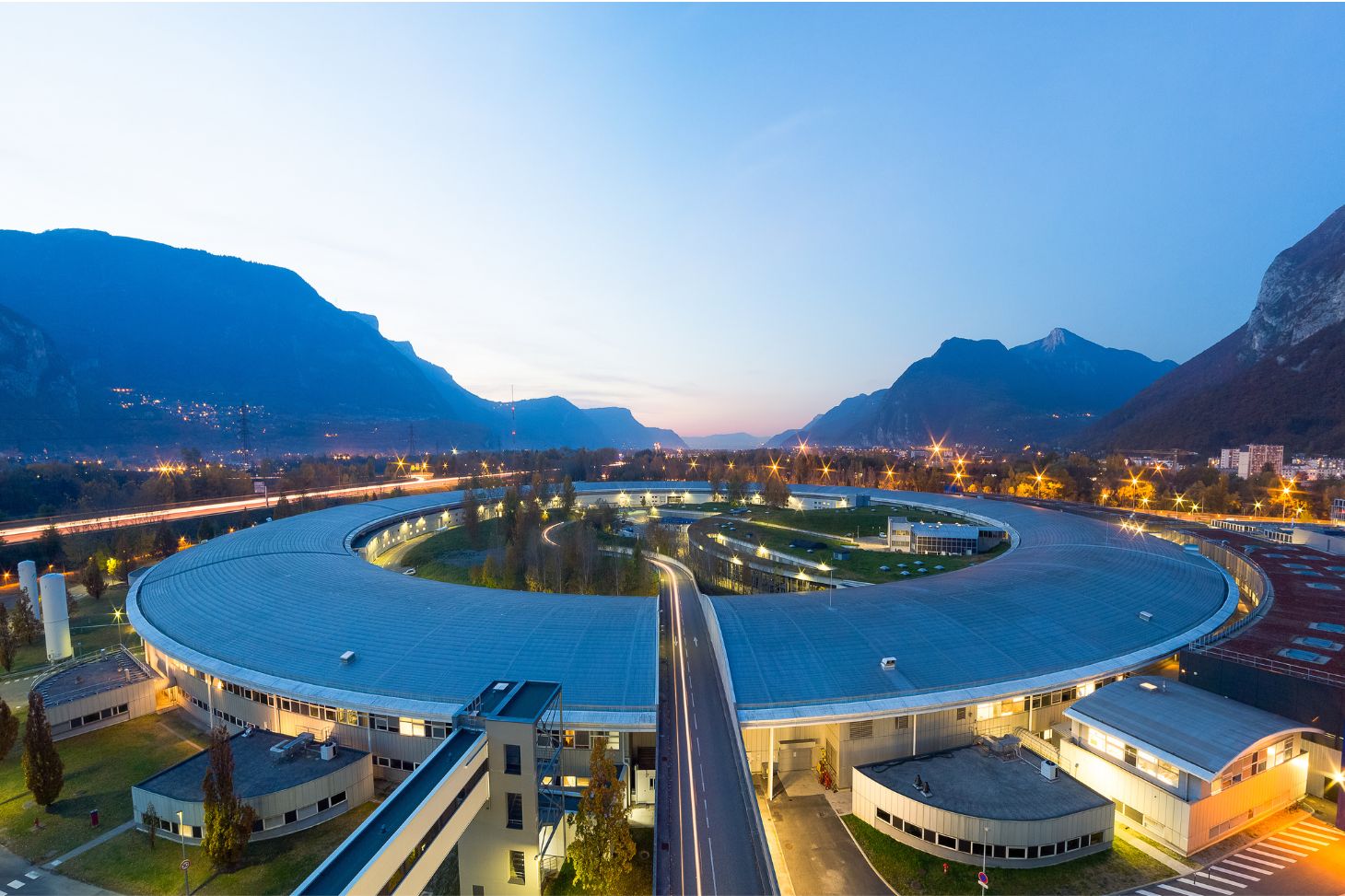
Université Grenoble Alpes (UGA), a long-standing partner of the region's major research infrastructures, is stepping up its scientific collaboration through the GATES (Grenoble ATtractiveness and ExcellenceS) project. This ambitious program aims to develop excellent research projects and strengthen Grenoble's attractiveness as a scientific hub of international stature. As part of this program, UGA plans to implement more than 24 theses co-directed with ESRF (European Synchrotron Radiation Facility) by 2032. To date, 6 doctoral contracts have already begun, following calls for IRGA (Initiatives de Recherche à Grenoble Alpes) projects. Meet the award-winning PhD students!
A springboard for research and innovation
The co-supervised theses under the GATES program offer doctoral students unique opportunities: dual scientific supervision, access to state-of-the-art infrastructure, and high international visibility. This program boosts UGA’s scientific excellence and strengthens its position within major global research networks.
Doctoral Awardee Profiles
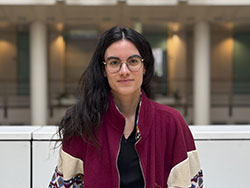 Lucie Canet, is a doctoral student at Université Grenoble Alpes in École doctorale Sciences de la Terre, de l’environnement et des planètes. Her thesis project, co-directed with ESRF at the Institut des Sciences de la Terre (ISTerre - UGA / CNRS / USMB / IRD /Université Gustave Eiffel), is entitled “Effects of iron and volatile elements on the structure and density of deep silicate melts”.
Lucie Canet, is a doctoral student at Université Grenoble Alpes in École doctorale Sciences de la Terre, de l’environnement et des planètes. Her thesis project, co-directed with ESRF at the Institut des Sciences de la Terre (ISTerre - UGA / CNRS / USMB / IRD /Université Gustave Eiffel), is entitled “Effects of iron and volatile elements on the structure and density of deep silicate melts”.Before embarking on her thesis, she followed a fairly straightforward academic path: a three-year Bachelor's degree in Earth and Environmental Sciences at the University of La Rochelle, followed by a two-year Master's degree in Exploration and Reservoir Geology at the University of Montpellier. It was his internships in analytical laboratories (in Liège, Belgium, and here at ESRF in Grenoble) that motivated him to pursue a thesis with a view to working in research later on.
His PhD project starting in November 2023 aims to understand the dynamics of the inner Earth, at a depth of 3000 km, through experimental techniques requiring the use of a synchrotron. The habitability of terrestrial planets and exoplanets is governed by their ability to store and preserve volatile compounds, such as H₂O, CO₂ or N₂ (collectively referred to as C-H-O-N), on geological timescales. In the early stages of their formation, planets experienced an entirely liquid state following large impacts, known as the Magma Ocean, which has significant implications for their subsequent evolution. To recreate the extreme conditions of the deep Earth in terms of pressure and temperature, she uses the pulsed laser-heated diamond anvil cell (LH-DAC) combined with X-ray diffraction (XRD), taking advantage of the synchrotron source at ESRF in Grenoble. She is also affiliated with the ISTerre laboratory at Université Grenoble Alpes, which specializes in geodynamics and geophysics. This affiliation complements his work at ESRF, offering a broader perspective by combining state-of-the-art synchrotron experiments with expertise in Earth and planetary sciences. Her PhD work involves laboratory experiments, data processing, and reading and writing scientific papers. She also has the opportunity to attend training courses and conferences in her field of research several times a year. These experiences considerably enrich her knowledge and enable her to keep abreast of the most recent advances in planetary science.
She is co-supervised by Guillaume Morard, teacher-researcher at IMPMC, Mohamed Mezouar and Angelika Rosa, researchers at ESRF.
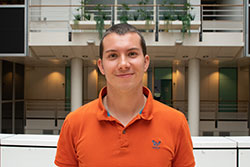 Clément Montembault is a PhD student at Université Grenoble Alpes within the École Doctorale de Physique. His thesis project, co-supervised with the ESRF and carried out at Institut Néel (CNRS / UGA), is entitled “Degradation processes of pigments from ancient Egypt.”
Clément Montembault is a PhD student at Université Grenoble Alpes within the École Doctorale de Physique. His thesis project, co-supervised with the ESRF and carried out at Institut Néel (CNRS / UGA), is entitled “Degradation processes of pigments from ancient Egypt.”After completing preparatory classes in MPSI/PSI*, he joined the physics department of ENS Paris-Saclay. He then obtained a Bachelor's degree in fundamental physics, followed by a Master's degree in Higher Education Training in preparation for the agrégation, and later the QLMN Master's program – Condensed Matter Physics – at Université Paris-Saclay. Wishing to pursue a PhD in a synchrotron facility focused on materials from cultural heritage, he naturally turned to the ESRF.
While the colors of objects from ancient Egypt often remain vivid, some of the inorganic pigments used have evolved over time. The aim of this thesis is to understand the degradation processes at play and to refine our knowledge of pigments and the artistic palette of Ancient Egypt. In this research project, which began in September 2023, various objects are being studied non-invasively using techniques such as X-ray diffraction and X-ray fluorescence, either on large-scale facilities or with portable instruments.
At the ESRF, he analyzed fragments of papyri depicting scenes from the Book of the Dead, which are preserved at the Champollion Museum in Vif (Isère department). He also carried out a measurement campaign on sarcophagi from the Third Intermediate Period at the Grenoble Museum, using portable instruments developed by the Néel Institute. In parallel, laboratory reproductions of degradation reactions are being conducted to assess the influence of various parameters on these processes.
This synergy between laboratory experiments, portable instrumentation, and synchrotron radiation enables an in-depth and comprehensive study of the available corpus of artworks, with the goal of understanding, documenting, and preserving them for future generations.
He is co-supervised by Catherine Dejoie, beamline scientist at the ESRF, and Pauline Martinetto, associate professor at the Néel Institute.
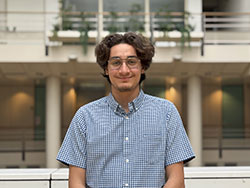 Ilies Bentamene is a PhD student at Université Grenoble Alpes within the École doctoraleIngénierie - Matériaux, mécanique, environnement, énergétique, procédés, production. His thesis project, co-supervised with the ESRF and conducted at the SIMaP Laboratory – Science and Engineering of Materials and Processes (CNRS / Grenoble INP – UGA / UGA), is entitled “Synchrotron nano-tomography-informed design of strain-delocalizing microstructures in additive manufacturing.”
Ilies Bentamene is a PhD student at Université Grenoble Alpes within the École doctoraleIngénierie - Matériaux, mécanique, environnement, énergétique, procédés, production. His thesis project, co-supervised with the ESRF and conducted at the SIMaP Laboratory – Science and Engineering of Materials and Processes (CNRS / Grenoble INP – UGA / UGA), is entitled “Synchrotron nano-tomography-informed design of strain-delocalizing microstructures in additive manufacturing.”After earning a science baccalaureate (Bac S), he pursued a DUT (University Technology Diploma) in Mechanical and Production Engineering at Université Lyon 1. He then went on to complete an engineering degree at UTC (Université de Technologie de Compiègne), during which he undertook two six-month research internships. These experiences sparked his passion for research and led him to pursue a PhD.
Metal additive manufacturing offers a unique way to produce complex geometries as well as out-of-equilibrium microstructures—both of which can enable highly specific mechanical properties. In this PhD project, which began in November 2024, Ilies focuses on laser powder bed fusion of a newly designed aluminum alloy specifically developed for this process. The goal is to explore the potential of mesoscale microstructure architecture to optimize mechanical performance.
To achieve this, he will leverage the process's ability to spatially vary microstructure distribution, followed by in situ tensile testing imaged via X-ray nano-tomography at the ESRF (beamline ID16B). 3D strain fields will be determined using digital volume correlation. Given the multiscale nature of the microstructure, he also aims to apply AI-based super-resolution strategies to obtain high-resolution volumes over large fields of view. Ultimately, the microstructures will be optimized by fine-tuning the process parameters.
He is co-supervised by Julie Villanova, beamline scientist in charge of ID16B at the ESRF, Pierre Lhuissier, researcher at SIMaP, and Guilhem Martin, professor at SIMaP.
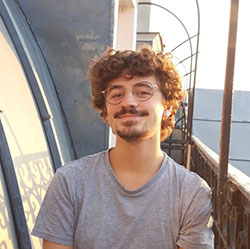 Fabien Letort is a PhD student at Université Grenoble Alpes within the École doctorale Sciences de la Terre, de l’environnement et des planètes. His thesis project, co-supervised with the ESRF and carried out at Institut des Sciences de la Terre (ISTerre – UGA / CNRS / USMB / IRD / Université Gustave Eiffel), is entitled “High-resolution and high-sensitivity methods to trace cadmium in plants.”
Fabien Letort is a PhD student at Université Grenoble Alpes within the École doctorale Sciences de la Terre, de l’environnement et des planètes. His thesis project, co-supervised with the ESRF and carried out at Institut des Sciences de la Terre (ISTerre – UGA / CNRS / USMB / IRD / Université Gustave Eiffel), is entitled “High-resolution and high-sensitivity methods to trace cadmium in plants.”After completing a Bachelor's degree in Earth Sciences at Sorbonne Sciences, with a specialization in Geochemistry, he earned a Master’s degree in Geochemistry at the Institut de Physique du Globe de Paris. He then worked for six months as a research assistant (Assistant Ingénieur) at ISTerre before beginning his PhD.
This research project, which began in October 2024, aims to enhance our understanding of cadmium uptake, storage, and detoxification in cacao plants through a multi-technique and multi-scale approach. Using the greenhouse at the Jardin du Lautaret in Saint-Martin-d’Hères, cacao will be grown hydroponically under various mineral deficiency conditions (zinc, manganese, and iron) while cadmium is added to the system. The study will also investigate the role of calcium in the formation of calcium oxalate crystals, which are known to detoxify cadmium in some plants (such as tomato, Gomphrena claussenii, and water hyacinth).
Subsequently, elemental analyses of the plant tissues (roots, stems, leaves) will be carried out on the Geochemistry-Mineralogy platform at ISTerre. Elemental mapping and speciation studies will be performed on several beamlines at the ESRF (ID21, BM20).
He is co-supervised by Géraldine Sarret (ISTerre) and Hiram Castillo-Michel (ESRF).
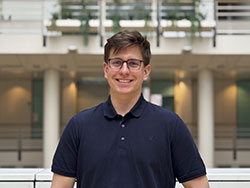 Thomas Sarrazin is a PhD student at Université Grenoble Alpes within theÉcole Doctorale de Physique. His thesis project, co-supervised with the ESRF and carried out at the laboratoire Modélisation et Exploration des Matériaux (MEM - CEA / UGA), is entitled “Spectroscopic Coherent Imaging of Nanoparticles during their Catalytic Reaction.”
Thomas Sarrazin is a PhD student at Université Grenoble Alpes within theÉcole Doctorale de Physique. His thesis project, co-supervised with the ESRF and carried out at the laboratoire Modélisation et Exploration des Matériaux (MEM - CEA / UGA), is entitled “Spectroscopic Coherent Imaging of Nanoparticles during their Catalytic Reaction.”After studying in California, he moved to France, where he completed two Bachelor's degrees in Econometrics and Physics, followed by a Master's in Soft Nanophysics at UGA, during which he undertook internships at the LIPhy laboratory and at the ESRF.
The goal of this PhD project, which began in November 2024, is to develop and apply a three-dimensional (3D), nano-focused, spectroscopic coherent imaging technique at the ID01-EBS beamline of the ESRF. The development of a robust algorithm for spectroscopic Bragg imaging will enable nanometric-scale imaging of complex crystalline materials in 3D—one of the major challenges in nanoscience today. This technique will be used to reveal both chemical information (oxidation states and bonding structure) and structural information (lattice strain, defects, morphology, composition). The research aims to uncover crucial insights into the dynamic behavior of catalysts under working conditions—for example, copper-based alloy catalysts under gas-phase environments—to gain a mechanistic understanding that can inform the design of efficient and selective CO₂ reduction catalysts.
He is co-supervised by Marie-Ingrid Richard, research director at CEA, and Vincent Favre-Nicolin, scientist and group leader at the ESRF.
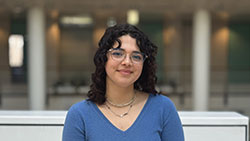 Emilia Di Prima is a PhD student at Université Grenoble Alpes within the École Doctorale Chimie et sciences du vivant. Her thesis project, co-supervised with the ESRF and carried out at the Laboratoire Chimie et Biologie des Métaux (LCBM - CNRS / CEA / UGA), is entitled “Design and Engineering of Artificial Enzymes for Green Energy.”
Emilia Di Prima is a PhD student at Université Grenoble Alpes within the École Doctorale Chimie et sciences du vivant. Her thesis project, co-supervised with the ESRF and carried out at the Laboratoire Chimie et Biologie des Métaux (LCBM - CNRS / CEA / UGA), is entitled “Design and Engineering of Artificial Enzymes for Green Energy.”She holds a Bachelor's degree in Biotechnology from the University of Padua (Italy) and a Master's degree in Industrial Biotechnology, also from the University of Padua. Her Master’s thesis, entitled “Development of an Extraction Method for the Purification of Conductive Fibers from Cable Bacteria,” was carried out in Antwerp (Belgium) with the support of the Erasmus+ EU4EU scholarship.
The artificial enzymology approach of this PhD project, which began in February 2025, aims to offer new perspectives on improving the activity of a small organometallic complex for CO₂ reduction, by leveraging the protein environment. Understanding how the peptide backbone regulates the catalytic activity of a metal cofactor bound to a protein is a key question in bioinorganic enzymology. This challenge will be addressed through a collaboration between LCBM and the structural biology group at the ESRF, as part of the IRGA “Large Instrument and MaCI Projects” initiative. The LCBM group will contribute its expertise in protein expression, purification, design, and enzymatic activity assessment. The ESRF, via beamlines ID30B and HPMX, will enable the structural determination of the protein and its CO₂ substrate, in order to further explore the structure–function relationships of these biohybrid systems.
She is co-supervised by Mohamed Atta (CEA), Christoph Mueller-Dieckmann (ESRF), and Philippe Carpentier (CEA/ESRF).
ESRF - The European Synchrotron - lighting the way to a brighter future
The ESRF is the world’s brightest synchrotron light source, providing scientists with brilliant X-rays to unveil the structure of materials and the mechanisms of life, down to the atomic level. A landmark for scientific excellence and a prime example of international collaboration, the ESRF unites researchers from all over the world in the quest to further knowledge and technology for the benefit of society.
In 1988, 11 countries joined forces to create the world’s first ‘third-generation’ X-ray light source – the most intense X-ray source in the world for the scientific community. In 2020, the ESRF made history again with the launch of a brand-new generation of high-energy synchrotron, the Extremely Brilliant Source (EBS).
With the support of its 19 international partner countries, ESRF-EBS provides scientists with unparalleled tools to expand the frontiers of research, enabling transformative discoveries that tackle complex scientific and societal challenges, including health, the environment, energy, and preserving humanity’s cultural heritage, lighting the way to a brighter, more sustainable and peaceful future.L'ESRF est la source de lumière synchrotron la plus brillante au monde, offrant aux scientifiques des rayons X d'une intensité exceptionnelle pour révéler les mécanismes de la vie et la structure des matériaux, jusqu'à l'échelle atomique.
The ESRF is the world’s brightest synchrotron light source, providing scientists with brilliant X-rays to unveil the structure of materials and the mechanisms of life, down to the atomic level. A landmark for scientific excellence and a prime example of international collaboration, the ESRF unites researchers from all over the world in the quest to further knowledge and technology for the benefit of society.
In 1988, 11 countries joined forces to create the world’s first ‘third-generation’ X-ray light source – the most intense X-ray source in the world for the scientific community. In 2020, the ESRF made history again with the launch of a brand-new generation of high-energy synchrotron, the Extremely Brilliant Source (EBS).
With the support of its 19 international partner countries, ESRF-EBS provides scientists with unparalleled tools to expand the frontiers of research, enabling transformative discoveries that tackle complex scientific and societal challenges, including health, the environment, energy, and preserving humanity’s cultural heritage, lighting the way to a brighter, more sustainable and peaceful future.L'ESRF est la source de lumière synchrotron la plus brillante au monde, offrant aux scientifiques des rayons X d'une intensité exceptionnelle pour révéler les mécanismes de la vie et la structure des matériaux, jusqu'à l'échelle atomique.
Published on April 15, 2025
Updated on April 15, 2025
Updated on April 15, 2025
LEARN MORe
The GATES project strengthens collaboration with the ILL. UGA and ILL already maintain strong ties through research partnerships and training programs. This cooperation fosters research and innovation, particularly in the fields of materials science, structural biology, chemistry, and nuclear and particle physics.
As part of the GATES project, an annual call for co-supervised PhD theses is launched. Formerly known as IRGA, the call is now titled GATES@UGA PhD and is announced and shared with laboratories in the fall. It allows research pairs (UGA–Large Instrument) to submit an application consisting of a research project. The selection results are published in the spring, with the PhD work beginning in the last quarter of the year.
As part of the GATES project, an annual call for co-supervised PhD theses is launched. Formerly known as IRGA, the call is now titled GATES@UGA PhD and is announced and shared with laboratories in the fall. It allows research pairs (UGA–Large Instrument) to submit an application consisting of a research project. The selection results are published in the spring, with the PhD work beginning in the last quarter of the year.

This project is supported by funding from the French government, managed by the National Research Agency under the Investments for the Future program, reference number ANR-22-EXES-0001.

